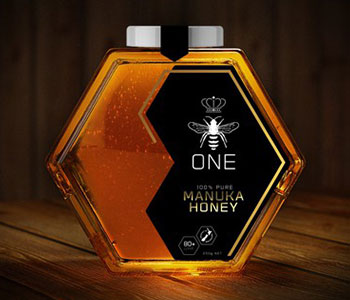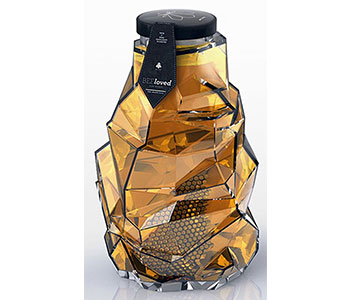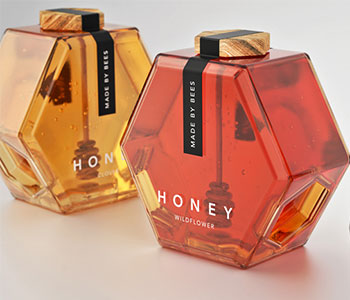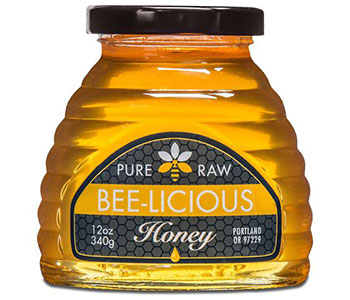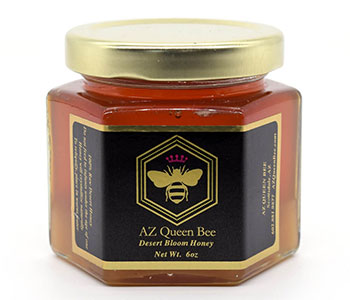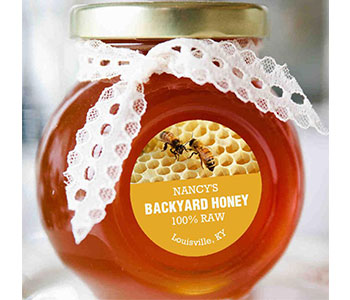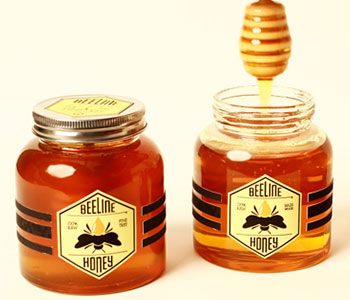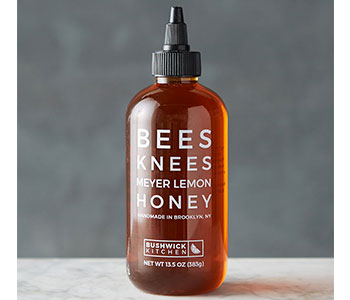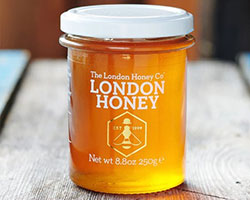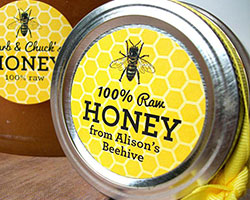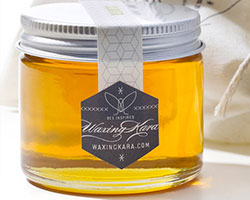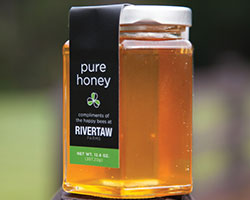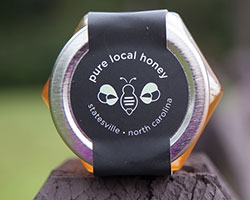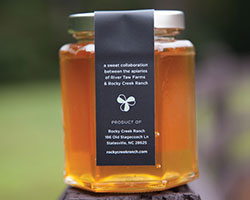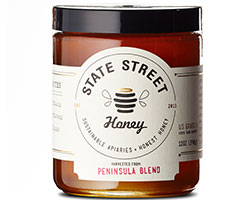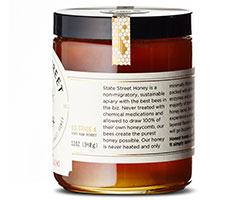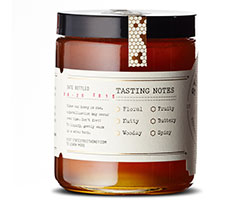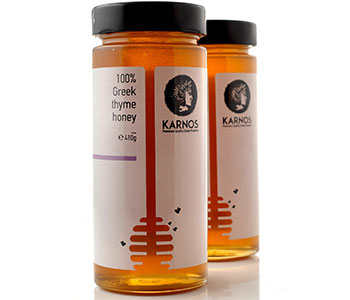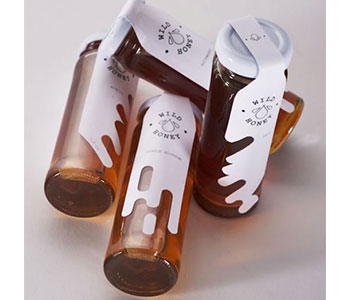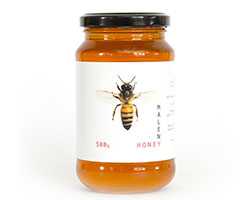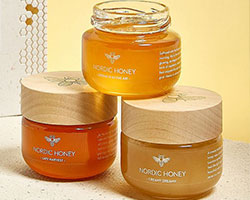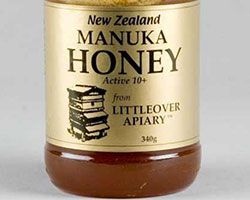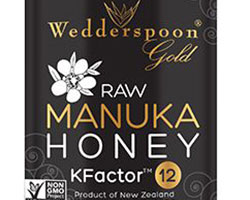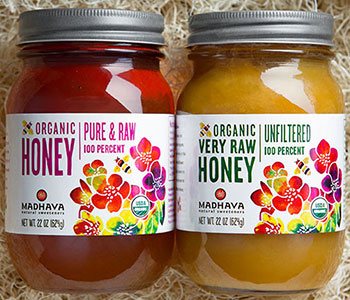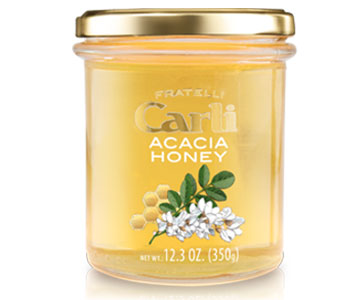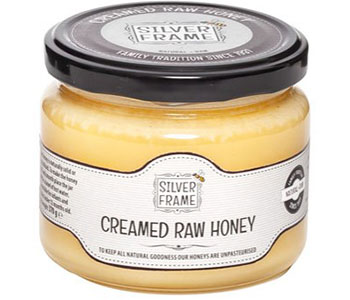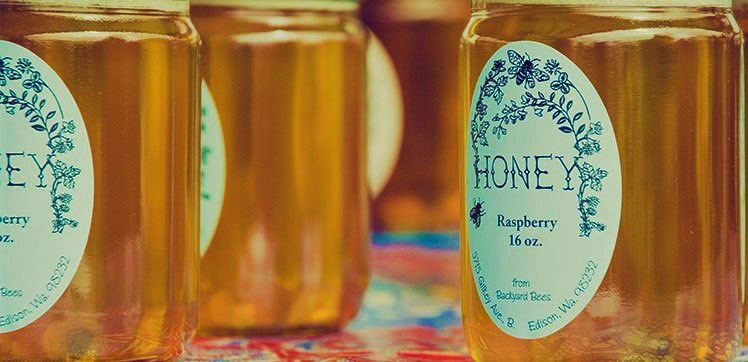
If honey is your “beesness” and you’re looking for inspiration to design your custom honey labels, you’ve landed at the right place.
“From the bee to your facility, honey is an all-natural, unprocessed ingredient straight from nature. Beekeeping is an art and a craft that connects honey bees to humans and our entire food system, from hive to table,” states the National Honey Board.
This golden and sweet relish is the evergreen of foods. People all over the world have been using it from ancient times to the present day, in any season of the year.
Natural sweetener for tea, coffee, and other beverages, it’s the first choice over sugar. The main ingredient in homemade sweets and desserts, or enjoyed on bread and pancakes at breakfast, honey rocks our taste buds. It works wonders on our skin, too. Not to mention its medicinal properties.
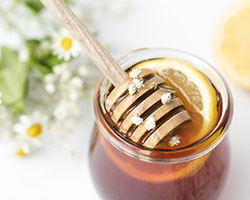
In this post you’re about to learn what are the steps to follow to craft original and enticing honey labels. No matter what type of honey you’re selling, you can definitely make those jars jump off the shelves and customers swarm your store. And we’re here to make sure of that.
Stay with me till the end and you’ll learn how to make amazing honey labels. Not only they will be eye-catching but also compliant.
Here we go.
1. Start With the Shape and Size of Your Honey Labels
The first thing to do is decide about the shape and size of your honey labels. But before you can do that, you have to think about the container you’re selling the honey in.
Is it a jar, a bottle, or a squeezable container? Its shape is actually the first thing to create impact. And it also determines the design characteristics of your labels.
Let’s see what this means.
Some containers have really unconventional shapes. It seems that the hex jar or the half skep jar is already past tense. Now, the real craze is the honeycomb cell shaped jars or other intricate shapes that are absolutely mind-blowing. Have a look at the ones below.
Amazing, right? Very creative.
There can be multiple sides, or angles, or special curves. This will influence the position, shape, and size of your labels a great deal. But don’t worry, there are also great labeling options that come in very handy.
Yet, most producers sell their honey in conventional packaging like the ones below.
Conventional, but very practical and effective. And this type of packaging offers more freedom for you to design your labels.
So depending on the shape of the container, you need to think about the position of the honey label. Where do you want to apply it? Where would it fit best to enhance the general looks of your product?
Or go with a one-piece label combining all three, going from one side to the other.
The advantage of a wrap-around label is that it gives you enough space to work with text or images. All around the jar, the necessary information is right there. And you can also send out your message to let customers know about you and your brand.
Even a special cutout is enough to create the desired effect.
Think which of these options combines perfectly with your jars and your brand’s style. Make them speak for you.
No matter what kind of container you’re selling your honey in and what shape you decide to give your labels, anything you think of, we can make it happen.
From the simplest label shapes of any size to custom and complex shapes and dies, plus exquisite embellishments, we go all the way to make sure your honey rocks the show. You can find out more about custom labels in our previous article.
Now, let’s take it a step further to see how exactly your labels will look like.
Here’s the next thing to do…
2. Choose Your Honey Label Material
No matter the shape and type of the container, make sure your honey labels will capture your honey brand’s personality and impact consumers.
One way to achieve that is by choosing the right MATERIAL for your honey labels.
Not only do they have to be eye-catchy, but they have to be of high-quality material. They need to be robust enough to stick well and last, and also withstand different conditions (like heat and cold, or humidity).
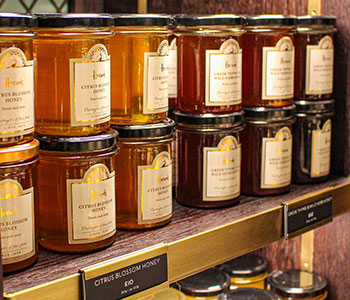
So if you’re wondering if it’s possible for your labels to have an outstanding design and also meet these criteria, let me lift the veil for you. It’s all possible.
We know our clients sweat blood in their work, and so do we.
At YourBoxSolution, all our labels are made of biaxially oriented polypropylene (BOPP). This is a durable material that makes them:
- Waterproof
- Heat resistant
- Sturdy & high-quality
- High-precision printing & cutting
- Print doesn’t smudge
- Write-on with a permanent marker
- Non-toxic
- Safe
Plus, they are easy to apply and peel. Technically, everything you’ve been looking for.
Now, which material do you think matches your style and honey jar?
White honey labels
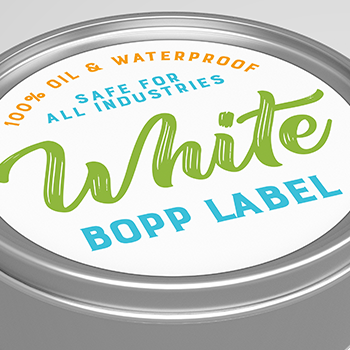
- Printed on white film
- Any color and design can be printed on top of the white background
- Excellent contrast to make special typography stand out
- Images are clearly visible
Clear honey labels
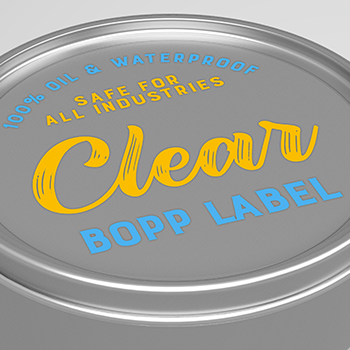
- Printed on transparent background film
- Professional and discreet, no-label look
- Honey shines through
- Consumers can see the honey while information stands out on the container
Metallic honey labels
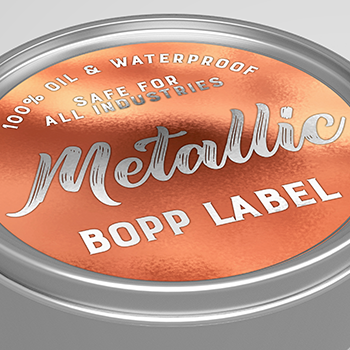
- Printed on a silver substrate
- Makes all printed colors appear shiny and reflective
- Perfect for the premium items of the line
- Elegant/premium look
Perhaps a sneak peek at the competition will help you get a clearer idea about what you would like for your own.
But wait. There’s more.
With extra customization you can add more value to your product.
What’s extra customization?
I’ll explain below.
It’s a post-print process that involves applying a “film” LAMINATE or a liquid COATING. This changes the look and feel of the finished label.
Already got your attention? Here’s the good news.
All YourBoxSolution labels are finished with a gloss or matte laminate for FREE.
Gloss laminated labels (FREE)
Perfect choice for a shiny finish and a very reflective surface of the label.
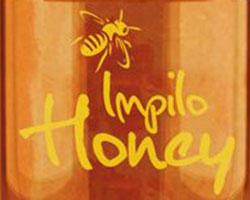
Dare to impress!
Matte laminated labels (FREE)
This subtle, non-glossy lamination gives labels a special effect.
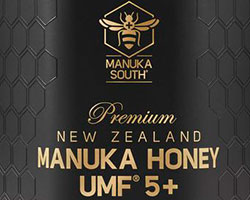
Stick in their mind!
Soft touch laminated labels
Shine-free and smooth surface – special sensation to touch and elegant look.
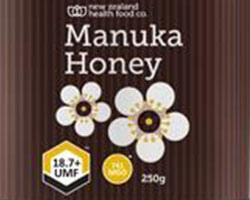
The bee’s knees!
Plus, if you combine coating and lamination with other extras, such as GOLD FOIL, you’ll make a truly unique and high-end honey label.
Gold foil
Gold foil stamping is the process of applying a metallic “foil” onto the label using a heated metal die and a press. When the die is applied to the substrate, the foil bonds to the surface, producing the metallic foil effect.
Perfect to emphasize a logo, typography, or design element.
So…You may have played a bit with your imagination, visualizing the shape and texture of the honey labels. That’s great!
But you don’t want to miss the next part about what’s actually going to be printed on the labels.
Here’s the third thing you need to do.
3. Create the Content for Your Honey Labels
If how your labels are shaped and the designed is alluring, what’s printed on them can be convincing.
Content is an important aspect of labeling. And when I refer to content, I mean both the text and any images that will appear on your honey labels.
They will tell the story of your brand and product. So choose the text, fonts, colors, and images carefully.
Colors
Fonts
When you choose your fonts, think about how it’s going to look on your label. You shouldn’t overlook this detail.
You want your fonts to be clear and readable — even if they’re on a tiny label. So make sure they are big enough to encourage customers to read.
Also, make them stylish, and don’t use more than two fonts. Too many different fonts can be very confusing for the eye. Plus, it’s not very professional.
At last, the contrast with the background is very important. You want the text to pop off and convey your message as clear as possible.
Images
Images are very suggestive and can do a wonderful job in conveying your message.
So use an image to represent and distinguish your honey. It will definitely make your jars stand out and people will be curious about it, too.
If you sell acacia honey, for example, a representative image of the plant on the labels will speak for itself. Or a honeycomb, or beehive.
Visuals, visuals, visuals… Success guaranteed.
You can read more about how to create packaging in our dedicated blog post.
And moving forward…
4. Make Sure Your Honey Labels Are Compliant
Everything’s nice and spice until it isn’t.
So before putting down any design ideas, make sure to check and follow the regulations in the industry.
A good practice is always the best choice to remain reputable.
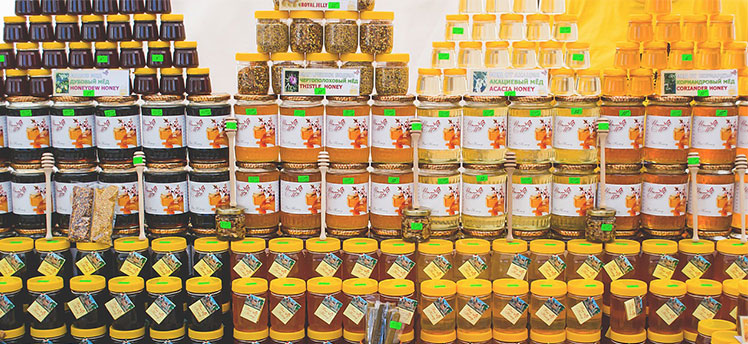
“The Food and Drug Administration (FDA) is responsible for assuring that foods sold in the United States are safe, wholesome, and properly labeled. This applies to foods produced domestically, as well as foods from foreign countries. The Federal Food, Drug, and Cosmetic Act (FD&C Act) and the Fair Packaging and Labeling Act are the Federal laws governing food products under FDA’s jurisdiction.”
In the meantime, I’ll list the main pieces of information that should appear on your honey labels. In this way, you’ll be able to think about what applies to you and how it’s best to present this information.
Now, let’s see what you’re supposed to write on your honey labels to make sure they are compliant.
- Type
Normally, people can see the type of honey through the jar just by looking at it. But of course, sometimes appearance can be misleading.
There’s a lot more to know about the collection and any processing of the honey. And not everyone is a connoisseur or understands much about it.
In fact, many people believe that only the golden nectar is the real deal and anything else is fake.
So if one of the types of honey you’re selling is creamed honey, for example, write it down wide and clear.
- Source
Another thing we recommend to add on the label is if the honey is blossom or nectar honey, or if it’s honeydew. There’s a real difference between them, and customers do have preferences.
- Floral source
Unifloral or multifloral. It’s also advisable to name your honey based on the predominant plant or blossom source. For example, Orange Blossom Honey, Acacia Honey, or Wildflower Honey.
- Country of origin
Maybe you’re not one of the local producers and you import honey from elsewhere. You’re required to mention the country of origin and also to follow the FDA and USDA’s regulations.
- Place of origin
It’s important to let customers know the topographical origin of the honey. If it comes from your own local production, tell them it comes from the far, estate, or village.
- Statement of identity
“According to the Codex Alimentarius of the United Nations, any product labeled as «honey» or «pure honey» must be a wholly natural product, although labeling laws differ between countries. In the United States, according to the National Honey Board (NHB; supervised by the United States Department of Agriculture), «honey stipulates a pure product that does not allow for the addition of any other substance… this includes, but is not limited to, water or other sweeteners».” Source
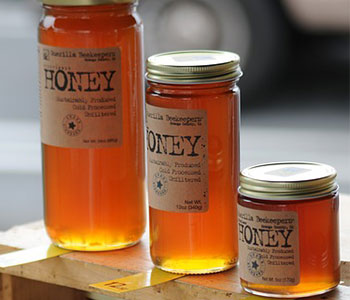
Honey lovers buy most raw and unpasteurized honey directly from the beekeepers. Or from the local honey farms. But things are not always so simple and straightforward.
Misbranding and honey adulteration are two major issues that this industry is facing. Most of the time, what people buy from supermarkets is not natural honey. It’s honey mixed with sweeteners. And this while the labels state otherwise.
- Nutrition facts
As honey is a food, the FDA’s Guidance recommends that the nutrition facts list is on the honey labels.
- Statement of ingredients
Perhaps your honey has a flavor ingredient. For example, a natural raspberry flavor. Choose a name that describes this characteristic. It can be “Raspberry honey” or “Raspberry-flavored honey.”
- Net weight
State the weight of the content without the jar or container and packaging. Use the metric weight (500 ml/g or 1 kg) or the U.S. measurement (16 oz).
- Other information
- Year of production
Honey can last for years so there’s not really an expiry date. “Best before” is acceptable. But the best choice is to specify the year of production or the date you bottle it.
- Lot marking
If you make honey in batches, mention the lot number. This helps trace and identify your products through the packaging and sales process.
- Name and address of the producer
Customers always check who produced the honey. So they’ll want to see your name and address on the label. Also, mention your website so they can find you quickly.
And this is what pretty much needs to appear on your honey labels. So take your time to put all the puzzle pieces together. In the end, your amazing artwork will speak highly of your brand.
I hope the information and ideas in this post sweetened your day and helped you get a picture of the honey labeling process.
You can also read our guides for:
When you’re ready to print your labels out…
5. Print Your Custom Honey Labels With YourBoxSolution
We’re more than delighted to make that happen.
In case you were wondering…
How are my honey labels packaged?
For all orders of 250 or more units, orders will be shipped on rolls with a 3″ diameter.
For orders of less than 250 units, labels will be shipped in one large roll that may be several labels wide.
And if you need rolls in a certain quantity or unwind direction, let us know and we’ll do our best to meet your needs. We can provide both the labels and various types of boxes for your business.
Art guidelines for your honey labels
What's the delivery time of my honey labels?
We know you’re a busy bee so we’re moving fast.
Once you place your order and we receive your artwork, we will create a digital proof for you to review. After you approve this proof, it’s just a matter of days until your honey labels will ship.
And the best part is that you don’t have to break your budget. You take care of the bees and we take care of you.

